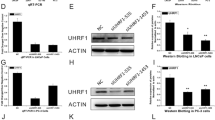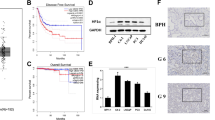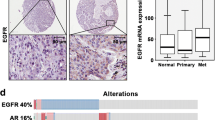Abstract
Objective
The majority of prostate cancers require androgen hormones for growth, and androgen ablation is an important part of the systemic treatment of advanced prostate cancer. Nevertheless, most of these cancers eventually relapse as they become less sensitive to androgen ablation and anti-androgen treatment. Elucidating the molecular events that are responsible for the conversion of androgen-sensitive cancers to androgen-refractory tumors may reveal new therapeutic opportunities.
Methods
In the present study, we investigated nine androgen-sensitive and nine androgen-refractory prostate cancer samples to evaluate the expression levels of 10 selected proteins that have been implicated in oncogenesis and cancer progression.
Results
Our immunohistochemical data show that three of the investigated proteins (i.e., minichromosome maintenance-2, methylguanine-DNA methyltransferase, and androgen receptor) are expressed at significantly different levels in the androgen-refractory cancer samples than in the androgen-sensitive tumors, whereas the expression levels of the seven other studied proteins (i.e., β-catenin, p27, p21, p16, Ki67, hypoxia-inducible factor 1 alpha, and geminin) are not significantly different regarding the two groups.
Conclusions
Our data suggest that the increased expression of minichromosome maintenance-2 and decreased expression of methylguanine-DNA methyltransferase related to androgen receptor are indicative of the androgen-refractory stage in prostate cancer. Further studies are required to determine whether these expression changes play a causative role in the transition of androgen-sensitive to androgen-refractory prostate cancer.

Similar content being viewed by others
References
Jemal A, Siegel R, Xu J, Ward E (2010) Cancer statistics, 2010. CA Cancer J Clin 60(5):277–300
Diokno AC (1998) Epidemiology of prostate cancer. West J Med 169(2):111–112
Mottet N, Bellmunt J, Bolla M et al (2011) EAU guidelines on prostate cancer. Part II: treatment of advanced, relapsing, and castration-resistant prostate cancer. Eur Urol 59(4):572–583
Hadaschik BA, Gleave ME (2007) Therapeutic options for hormone-refractory prostate cancer in 2007. Urol Oncol 25:413–419
Williams EM, Higgins JP, Sangoi AR et al (2014) Androgen receptor immunohistochemistry in genitourinary neoplasms. Int Urol Nephrol 47(1):81–85
Grossmann ME, Huang H, Tindall DJ (2001) Androgen receptor signaling in androgen- refractory prostate cancer. J Natl Cancer Inst 93:1687–1697
Scher HI, Sawyers CL (2005) Biology of progressive, castration-resistant prostate cancer: directed therapies targeting the androgen-receptor signaling axis. J Clin Oncol 23(32):8253–8261
Titus MA, Schell MJ, Lih FB et al (2005) Testosterone and dihydrotestosterone tissue levels in recurrent prostate cancer. Clin Cancer Res 11(13):4653–4657
Shiota M, Yokomizo A, Naito S (2011) Increased androgen receptor transcription: a cause of castration-resistant prostate cancer and a possible therapeutic target. J Mol Endocrinol 47(1):25–41
Vis AN, Noordzij MA, Fitoz K et al (2000) Prognostic value of cell cycle proteins p27(kip1) and MIB-1, and the cell adhesion protein CD44s in surgically treated patients with prostate cancer. J Urol 164(6):2156–2161
Nikoleishvili D, Pertia A, Trsintsadze O et al (2008) Expression of p27((Kip1)), cyclin D3 and Ki67 in BPH, prostate cancer and hormone-treated prostate cancer cells. Int Urol Nephrol 40(4):953–959
Kudahetti SC, Fisher G, Ambroisine L et al (2010) Transatlantic Prostate Group. Immunohistochemistry for p16, but not Rb or p21, is an independent predictor of prognosis in conservatively treated, clinically localised prostate cancer. Pathology 42(6):519–523
Omar EA, Behlouli H, Chevalier S et al (2001) Relationship of p21(WAF-I) protein expression with prognosis in advanced prostate cancer treated by androgen ablation. Prostate 49(3):191–199
Szász AM, Majoros A, Rosen P et al (2013) Prognostic potential of ERG (ETS-related gene) expression in prostatic adenocarcinoma. Int Urol Nephrol 45(3):727–733
Zhao JH, Luo Y, Jiang YG et al (2011) Knockdown of β-Catenin through shRNA cause a reversal of EMT and metastatic phenotypes induced by HIF-1α. Cancer Investig 29(6):377–382
Dudderidge TJ, McCracken SR, Loddo M et al (2007) Mitogenic growth signalling, DNA replication licensing, and survival are linked in prostate cancer. Br J Cancer 96(9):1384–1393
Park JY (2010) Promoter hypermethylation in prostate cancer. Cancer Control 17(4):245–255
Williams SG (2006) Characterization of the behavior of tree definitions of prostate specific antigen-based biochemical failure in relation to detection and follow-up biases: comparison with the American Society for Therapeutic Radiology and Oncology consensus definition. Int J Radiat Oncol Biol Phys 64(3):849–855
Hussain M, Goldman B, Tangen C et al (2009) Prostate-specific antigen progression predicts overall survival in patients with metastatic prostate cancer: data from southwest oncology group trials 9346 (intergroup study 0162) and 9916. J Clin Oncol 27(15):2450–2456
Grossmann ME, Huang H, Tindall DJ (2001) Androgen receptor signaling in androgen-refractory prostate cancer. J Natl Cancer Inst 93(22):1687–1697
Jeronimo C, Henrique R, Oliveira J et al (2004) Aberrant cellular retinol binding protein 1 (CRBP1) gene expression and promoter methylation in prostate cancer. J Clin Pathol 57(8):872–876
Jeronimo C, Henrique R, Hoque MO et al (2004) A quantitative promoter methylation profile of prostate cancer. Clin Cancer Res 10(24):8472–8478
Kang GH, Lee S, Lee HJ et al (2004) Aberrant CpG island hypermethylation of multiple genes in prostate cancer and prostatic intraepithelial neoplasia. J Pathol 202(2):233–240
Maruyama R, Toyooka S, Toyooka KO et al (2002) Aberrant promoter methylation profile of prostate cancers and its relationship to clinicopathological features. Clin Cancer Res 8(2):514–519
Yamanaka M, Watanabe M, Yamada Y et al (2003) Altered methylation of multiple genes in carcinogenesis of the prostate. Int J Cancer 106(3):382–387
Mishra DK, Chen Z, Wu Y, Sarkissyan M, Koeffler HP, Vadgama JV (2010) Global methylation pattern of genes in androgen-sensitive and androgen-independent prostate cancer cells. Molecular cancer therapeutics 9(1):33–45
Feldman BJ, Feldman D (2001) The development of androgen-independent prostate cancer. Nat Rev Cancer 1(1):34–45
Melixetian M, Helin K (2004) Geminin: a major DNA replication safeguard in higher eukaryotes. Cell Cycle 3(8):1002–1004
Meng MV, Grossfeld GD, Williams GH et al (2001) Minichromosome maintenance protein 2 expression in prostate: characterization and association with outcome after therapy for cancer. Clin Cancer Res 7(9):2712–2718
Romics I, Bánfi G, Székely E et al (2008) Expression of p21(waf1/cip1), p27 (kip1), p63 and androgen receptor in low and high Gleason score prostate cancer. Pathol Oncol Res 14(3):307–311
Sugibayashi R, Kiguchi Y, Shimizu T et al (2002) Up-regulation of p21(WAF1/CIP1) levels leads to growth suppression of prostate cancer cell lines. Anticancer Res 22(2A):713–719
Dai Y, Bae K, Siemann DW (2011) Impact of hypoxia on the metastatic potential of human prostate cancer cells. Int J Radiat Oncol Biol Phys 81(2):521–528
Acknowledgments
We thank Levente Herényi (Department of Biophysics and Radiation Biology, Semmelweis University, Budapest, Hungary) for his continuing support of this research.
Conflict of interest
The authors declare that they have no conflict of interest.
Author information
Authors and Affiliations
Corresponding author
Rights and permissions
About this article
Cite this article
Bánfi, G., Teleki, I., Nyirády, P. et al. Changes of protein expression in prostate cancer having lost its androgen sensitivity. Int Urol Nephrol 47, 1149–1154 (2015). https://doi.org/10.1007/s11255-015-0985-1
Received:
Accepted:
Published:
Issue Date:
DOI: https://doi.org/10.1007/s11255-015-0985-1




